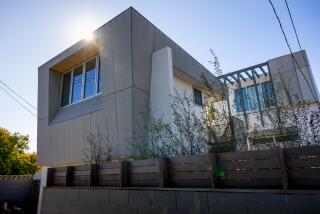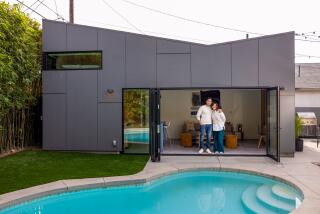New bathroom was due
Toward the end of her pregnancy, Cindy Fitzgerald had two goals: to remodel the bathroom where she would care for the new baby and to get it done before she delivered.
“I didn’t want the construction in the baby’s face,” said Fitzgerald, who lives in a 1930s two-bedroom, two-bathroom home in Venice with her husband, Jon; the newborn, Grayson; and a daughter, Sidney, 6.
But the project was stalled by a quandary: high-end desires and a midrange budget.
Her solution -- boxes of expensive glass tile left over from a high-end remodel -- was spotted by Fitzgerald in the Brentwood garage of interior designer Lara Fishman, whose daughter Olivia, 6, is a classmate of Sidney’s.
“Your trash would redo my bathroom,” Fitzgerald recalled telling Fishman during a play date for their daughters. After all, her bathroom -- at barely 30 square feet -- would not require much material.
“Take it,” Fishman said.
From that starting point, the two women gathered other leftover high-end building materials, including porcelain tiles for the floor, wood for a vanity and a small piece of Caesarstone for the countertop. Fishman designed the new bathroom, and Fitzgerald hired a contractor, found through another school family, to build it.
For $15,200, Fitzgerald got a sleek new bathroom with materials that Fishman, whose business is Designers Call, figures would have cost more than $19,000 if all the materials were purchased new.
Before it was remodeled, the bathroom hadn’t been welcoming for a mother and her newborn.
The tub was shallow, which was a problem for Fitzgerald, who is big on baths. It had a shower curtain and was surrounded by large tan tiles with brown grout, a popular look in the 1980s, but not now. A small vanity sat beneath a mirror and a cheap-looking stainless-steel light fixture. Faded linoleum covered the floor.
Using the leftover materials they found and the upscale fixtures and details Fitzgerald wanted, the two women planned the new bathroom.
The centerpiece of the room would be the largest and deepest tub that could fit into the space --a Kohler Tea-for-Two. Fitzgerald did not want a shower curtain or sliding doors, and she especially didn’t want a track pushing into her stomach as she leaned over the tub to bathe the baby. The solution was a European-style glass partition like she’d seen used in Fishman’s own remodel. It consists of one panel of thick glass near the faucet end of the tub, with another piece hinged onto the side.
For fixtures, she wanted the whole array, including a rain-type shower head and a hand-held shower head for help in bathing the baby.
The 2-inch-by-1-inch glass tiles, which had gotten this remodeling started, would cover the wall from the top of the tub to the ceiling on three sides and the side of the tub. It turned out to be an expensive gift from Fishman to Fitzgerald. At $24 a square foot, the 96 square feet of wall space would have cost about $2,300 in material alone.
For the vanity, which would be attached to the wall and “float” above the floor without supporting legs, Fishman asked a dealer for some materials left over from a larger job. The vanity was built in a shop and stained on-site. It was Fitzgerald’s idea to add several open shelves near the tub side of the vanity to store extra towels.
The Caesarstone countertop was a relatively small piece, at 24 inches by 46 inches, left over from another job. Although it cost Fitzgerald $300 for the material, she would have had to spend $800 on a full sheet if she’d been remodeling the normal way. Cutting and installation cost extra and was included in the contractor’s fee. Extra pieces were used to create a backsplash high enough for wall-mounted faucets, and other pieces were cut to create a nook in the area for bath products.
One of Fitzgerald’s splurges were two side-by-side medicine glass-shelved cabinets, mirrored on the doors and also mirrored inside, and set into the wall.
The decision to set the cabinets into the wall, rather than attaching them to the surface of the wall like the previous mirror, added to the complexity of the project and cost $500 more since pipes in the wall had to be rerouted.
And the new floor was covered with Italian tiles Fishman had left over from her own remodel. At $22 per square feet, it amounted to a savings of several hundred dollars -- another gift between friends.
With the design set, Fitzgerald got a bid from the contractor for $10,000 for the labor. He hung plastic sheeting to protect the rest of the house from dust.
The job took about six weeks to complete, and it was not an easy time for the pregnant Fitzgerald. With the construction site adjacent to her bedroom, she had to get her daughter ready for school and be ready for workers to arrive at 8 a.m.
Plus, without a general contractor taking charge of the whole project, Fitzgerald had to play the role of project manager and make sure the designer’s wishes, and her own, were carried out.
“It was very stressful,” she said.
As it turned out, the deep new tub was perfect for Fitzgerald as she went into labor. With the midwife in attendance, she soaked in the warm tub until it was time to go to the hospital and deliver her son.
Remodeling with leftover materials is not for everyone. It takes time to track down materials and to find exactly what one wants.
“It’s more work,” Fishman admitted.
However, the experience of helping her friend has helped push Fishman’s business toward a new green focus. She envisions a whole warehouse someday filled with high-end building materials leftover from bigger jobs.
There are often leftover materials, she said, because contractors routinely order more than needed for a job, just in case more end up being required, or there are color-matching issues, or in case something is delivered broken or breaks on-site. Ordering more tile after such emergencies occur can set back a job by weeks or months.
Fishman calls the idea of using new, surplus materials “upcycling.”
“The time is so right to use these items,” she said.
And, in fact, Fitzgerald has another bathroom to remodel. But with her new baby, she’s in no hurry to live through another remodel.
“I think you need time to heal,” she said.
--


